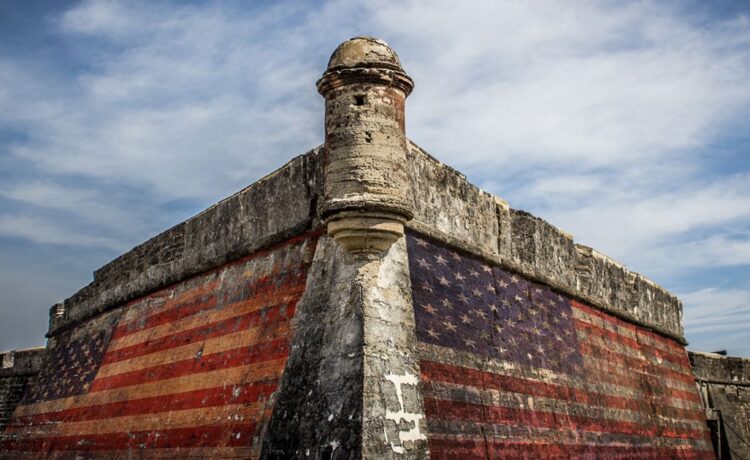When global business and political leaders departed from this January’s edition of Davos, the World Economic Forum’s annual meeting and a bellwether event for gauging economic sentiment, they left a world irrevocably changed. The conference began on Jan. 20, just as Donald Trump was sworn in as president and started his second term with a swarm of executive orders, and concluded a few days later.
According to Sam Chandan, founding director and professor at New York University’s Chao-Hon Chen Institute for Global Real Estate Finance, who was in attendance, the overall geopolitical conversation at the event was “sober, as you would expect.”
But the tone was markedly different when it came to real estate.
“There was a widely held sentiment among industry leaders that cross-border investment flows in real estate are poised to strengthen in 2025,” Chandan said.
Forecasts envision a freer flow of global real estate capital in 2025, despite significant currents of economic uncertainty. The U.S. is expected to capture the bulk of that capital. A Savills report forecasts $542 billion in total commercial real estate investment in the U.S., a 39 percent annual jump and well ahead of any year since 2021. Globally, Savills anticipates $952 billion in investment in 2025, itself a 27 percent increase.
“There’s more groups investing again, more groups on offense, and also some early green shoots from some of the core investors who have been on the sidelines the past couple of years,” said Lauro Ferroni, JLL (JLL)’s head of capital markets research for the Americas.
This is despite a significant share of that global uncertainty emanating from the United States, and the policies and America First position of a re-elected Trump. It’s simply much harder to deploy capital at scale without investing here.
Recent activity underscored that. In November, Japan’s Mori Group took an 11 percent stake in New York City’s One Vanderbilt in a deal that valued the office tower at $4 billion. The same month, a Japanese real estate investment trust bought a Washington, D.C., mixed-use campus for $279 million. In January, Norway’s Norges Bank bought a 45 percent stake in a 48-building logistics portfolio, most of it in Southern California, for $1.07 billion.
JLL expects such institutional investors will become more active this year, chasing gains in a market offering “heightened complexity and performance.” The U.S., which some see on the cusp of a true real estate recovery, remains a magnet for capital that’s been sitting on the sidelines for years.
“A lot of the discussion right now is focused on the potential for tariffs with major trading partners,” said Chandan. “But the investment flow into the U.S. will not be hindered significantly.”
Regardless of the size of the surge in real estate investing in the U.S. this year, the market will act far differently than it did a decade ago. Back then, fueled by Asian money, overseas players snapped up trophy office towers. The assets attracting the big bucks today remain more specialized, including senior and student housing, cold storage, logistics, industrial outdoor storage and data centers. Emirati billionaire Hussain Sajwani, for instance, pledged to invest $20 billion in data centers during a press conference with Trump at Mar-a-Lago last month.
Investors see more opportunity for U.S. asset value to increase. The nation’s GDP is forecast to grow 1.9 percent in 2025 per the International Monetary Fund, outpacing the euro area, and expectations are that interest rates will come down over time.
Changing currency values, especially a stronger U.S. dollar, mean that acquisitions will get more expensive for foreign investors, however, and therefore impact the investment calculus. Factor in the nature of the assets being sought — and the shoot-from-the-hip trade policies of Trump — and much more due diligence will be required to assess properties and potential risks. It suggests a year of increased, but perhaps incremental, investment, with flashy trophy office sales making way for larger, more complex, multi-asset portfolio deals requiring a lot more work to underwrite and close.
Timing also appears to bolster bigger bets on the U.S. Many observers think the market has hit bottom, creating an opportune time to buy cheap and ride a recovery, said Chandan, especially in sectors like office that have attracted nothing but hesitancy in recent quarters. Many European investors have made big bets on office due to a perception of buildings being priced to move. These bets include luxury retailer Prada’s purchase at the start of 2024 of two Fifth Avenue buildings for roughly $822 million.
And then there’s the reality that, over the last decade, a real competitor for global capital hasn’t really emerged.
“Look at the United Kingdom, Germany is sort of in a recession, and Canada is conservative and very uncertain,” said Chandan. “The central bank in a lot of these places is still easing monetary policy. The growing differential between the United States and other parts of the world will reinforce the strength of the U.S. dollar.”
Part of the reason 2024 was relatively anemic in terms of foreign investment was the lack of true, Class A, modern, investment-grade product on the market, said Alex Foshay, Newmark (NMRK)’s executive vice chairman and head of international capital markets. Last year, his team sold Arboretum Gateway in Santa Monica, Calif., under a 12-year lease from Universal Music, and more than half the significant bidders came from overseas. Two of the three finalists were a German pension fund and a Taiwanese family office. (Ultimately, Drawbridge Realty, a San Francisco-based privately held real estate investment company, won out.)
This year, Foshay believes the active foreign investment pool will deepen and broaden, including via Australian super funds, Middle Eastern sovereign wealth funds, Canadian pension plans, Singaporean REITs, ultra-high-net-worth family offices and Japanese real estate investment companies.
Trump’s agenda remains predicated on bringing economic activity and investment back to the U.S. Some policy changes, like relaxed regulations on banking and finance, expanded Opportunity Zone investments and more tax incentives, could entice more foreign dollars.
But there remain aspects of this outlook that might spook foreign investors, not the least being trade wars between allies.
Canada — a major tariff target for the Trump administration — remains a key investor in U.S. property. Another area of possible concern may be actions limiting foreign ownership on national security grounds, a position espoused by influential conservative groups. Speculatively, that may look like using the power of the Committee of Foreign Investment in the United States, a Treasury Department agency, to block investment in critical infrastructure or data centers due to international competition over AI. Some see Florida’s ban two years ago on real estate investment from China and other countries of concern as a possible sign of things to come.
Then there’s the potential for disruptions around trade and tariffs. Despite a quick move to delay implementation, the rapid-fire manner in which the U.S. applied then delayed substantial tariffs on close allies Mexico and Canada certainly got the attention of foreign capital. Chandan argued that the market, right or wrong, was discounting the chance of a protracted trade war, instead viewing tariff threats as a policy and negotiation tool. (When asked at the Real Estate Board of New York’s gala last month, many of the New York owners Commercial Observer interviewed indicated the same.)
Alternately, Jim Costello, chief economist of real assets at MSCI, said that tariffs create uncertainty, an economic shock that could cause a decline in demand for assets like industrial or office. That forces investors to underwrite a separate set of conditions, and the time spent doing so can kill potential deals.
Some of the optimism about increased capital inflows may be misplaced, too, Costello said. For one, the last cycle saw a gusher of Chinese money in the 2010s fuel buying sprees and drive up prices, a boom that will not repeat itself due to Chinese government capital restrictions. In 2015, foreign capital represented 14 percent of the total money invested in U.S. real estate, per JLL.
Today’s cross-border investors more closely resemble typical institutional investors with decades of global experience managing money for entities such as pension funds. In the United States in 2024, institutional investors sold more assets than they bought on a net basis. It’s the private investors, with their own money, who made bets on record low prices.
“When you talk to them about investments in Houston or St. Louis or Atlanta, they know those markets, they’re not just coming to the big global gateway markets,” Costello said. “For them, the motivations aren’t capital preservation and diversification. It’s about hitting the target.
“The cross-border investors coming back are mostly institutional,” he continued. “They’re putting pension money to work and tend to be more cautious. If the rules start changing a lot, they’ll fall back. But nothing is written in stone yet.”

















